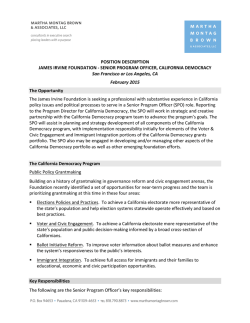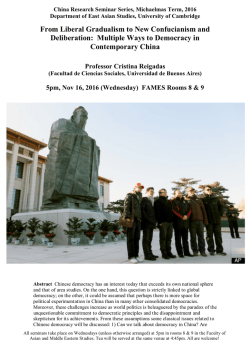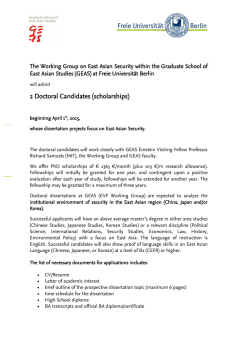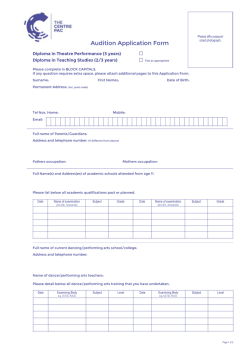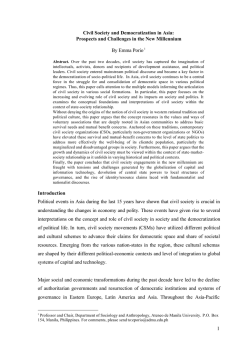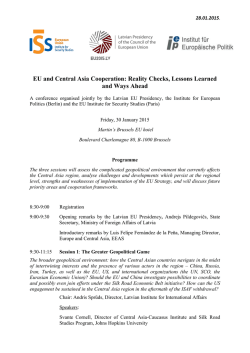
1 EDITORIAL Education and Identity Formation in Post-Cold
EDITORIAL Education and Identity Formation in Post-Cold War Eastern Europe and Asia Jan Germen Janmaat and Edward Vickers Only twenty years ago the communist states in Eastern Europe and East Asia were remarkably similar in terms of both their dominant ideologies and their economic structures. In both regions the Communist Party exercised supreme control over the economy, politics and cultural life. Public education was geared towards delivering technicians and professionals faithful to party and state and satisfied with the narrow range of intellectual pursuits permitted by the authorities. The humanities (history, literature) and social studies (geography, civics) in particular served to nurture unconditional loyalty to communist ideology, while suppressing heterodox views. However, since the mid-1980s, crisis in the command economy and a failure to keep pace with the West in technological development have motivated or compelled political elites in both regions to liberalise their economies and engage in market reforms. This, however, is where the similarities between the two regions end. From the late 1980s the two regions have followed radically different trajectories. While China and Vietnam have restricted reform to the economic sphere, the former Warsaw Pact countries matched their new economic liberties with greater freedom in the political and cultural arenas. This freedom set in motion an uncontrollable chain of events that not only led to the demise of communism but also to the disintegration of several multinational federal states. From the ashes of these states—the Soviet Union, Yugoslavia and Czechoslovakia—a multitude of new sovereign nations arose, most of which had little or no recent history of independent statehood. With the exceptions of Belarus and Turkmenistan, these new states have—at least formally— embraced the principles of liberalism, democracy and the rule of law. At the same time, the post-communist states in Eastern Europe have sought to win international recognition and prestige by joining bodies such as the Organization for Security and Cooperation in Europe (OSCE) and the Council of Europe (COE), intergovernmental organizations that promote and monitor democracy, human rights, freedom of speech and interethnic tolerance. Almost all of these states have signed international treaties committing them to pursue liberal-democratic policies and have invited the OSCE and the COE to undertake joint projects aimed at reforming and democratizing their national education systems. Some states have moved beyond this and have voluntarily ceded some decision-making autonomy by acceding to the European Union and NATO. Others still aspire to become members of these supranational organizations. By contrast, regional forms of integration are conspicuously absent in East Asia. According to Vickers (2005), this difference has its origins in the Cold War era. Whereas West-European leaders, urged on by the Americans, moved swiftly after 1945 to establish cooperative military and economic structures as a counterweight to the Eastern Bloc, East Asian states were never called upon by the Americans to take joint responsibility for their own security, and, as a consequence, remained thoroughly inward-looking in the post-war period. Hein and Selden (2000) hold this differential rate of regional integration to be the key factor explaining the contrasting ways in which Germany and Japan have dealt with their wartime histories. While Germany had no choice but to look its Nazi past in the face in order 1 to be accepted as a trustworthy partner within international structures such as the EEC/EU, Japan lacked any similar incentive to undertake such searching scrutiny of its own role in World War II. Diverging educational trajectories All these observations raise an interesting set of questions: Have the diverging political trajectories of Eastern Europe and East Asia over the past fifteen years been reflected in the teaching of humanities and social science disciplines? Or, to put it more directly, is education in states such as China and Vietnam still imposing a single, ideologically-slanted vision of society and history, while in Eastern Europe, greater recognition of diversity has replaced the crude political indoctrination of the past? If the teaching of ‘sensitive’ disciplines has indeed developed differently in these two regions, can pedagogical trends be directly related to the diverging political trajectories? And to what extent can change (or the lack of it) in dominant political ideologies and educational philosophies be attributed to cultural or historical factors that predate and transcend the recent legacy of communism and the Cold War? These are the concerns that motivate the current special issue. It is tempting to jump to conclusions and argue that political change and the development of disciplines such as history are so obviously related that there is little need for academics to labour the fact. Yet, on close inspection it is difficult to make a case for democracy and regional integration as sufficient conditions for pluralist educational practices. Democracy and liberalism have not prevented Western powers from using education to promote patriotism and feelings of national superiority in the past. Marsden (2000), for instance, notes that British, French and American history and geography textbooks rivalled their German counterparts in the glorification of war and the vilification of neighbouring nations in the first half of the twentieth century, despite the efforts of the League of Nations to curb rampant chauvinism. This precedent appears to demonstrate that liberal democratic political structures are in themselves no guarantee of pedagogical liberalism, although within a broader context of international integration they can function as a necessary (though not sufficient) precondition for liberal educational reforms. Indeed, encouraged by UNESCO and the Council of Europe, West-European states began removing nationalist leanings and ethnic stereotypes from their educational materials after World War II (Berghahn & Schissler, 1987). Thematically, teaching materials tended to diversify, addressing socio-economic, cultural, gender and international issues in addition to the traditional themes of high politics and war. In terms of pedagogical objectives, they exchanged the inculcation of received identities, values and pre-digested ‘truths’ for the promotion of skills associated with active democratic citizenship—critical thinking, causal understanding and independent analysis. Parallel to this process, the emphasis in curriculum content shifted from the national to the international level. Discussing the evolution of history and civics textbooks in postwar France and Germany, Soysal, Bertilotti and Mannitz (2005) for instance argue that both countries (France later than Germany) have stopped seeing the national and transnational as rival notions and have firmly placed their national histories and identities in a European context. Nonetheless, scepticism regarding the real impact of regional integration has remained. Some commentators have argued that some of the newly independent states only wish to join the European Union and NATO for economic and security reasons. 2 The political elites of these states, it has been alleged, only participate in the OSCE and the COE in order to improve the prospects of their countries being accepted as members of the European Union or NATO, without being truly committed to the values the OSCE and the COE stand for. When placed in the international spotlight they welcome educational reforms supported by the COE, while behind the scenes taking steps to undermine these reforms. Even if this cynical view of the true intentions of East European policy makers proves to be false and curriculum designers and textbook writers prove to be genuinely embracing the values of democracy, freedom, human rights and tolerance, it still remains to be seen whether a discourse nurturing these values is accepted at the grass roots level. Until very recently, Eastern Europe frequently made the headlines for outbreaks of intolerant ethnic nationalism and brutal civil wars. Given their turbulent histories, people in the region have developed a profound distrust of politicians, state authority and government initiatives. In these circumstances teachers and parents may well sabotage top-down educational reforms preaching ethnic tolerance and challenging traditional modes of teaching. Meanwhile, it is debatable whether initiatives from the COE such as the Education for Democratic Citizenship programme are currently receiving a warm welcome even in Western Europe, supposedly the ‘model’ region regarding integration and cooperation. In recent years, public scepticism over the benefits of ongoing international (and interethnic) integration has grown, as witnessed by the rejection of the European Constitution in referenda in France and the Netherlands. Nor has the process of regional integration prevented a renewed eruption of xenophobic sentiments in Western Europe, as demonstrated by the recent electoral success of parties campaigning on populist anti-immigrant platforms in France, the Netherlands, Belgium, Denmark and Austria. While the notion of multiculturalism has fallen out of favour in public debate, there is a growing demand in some quarters for education to resume its traditional task of fostering unquestioned national identities. The need for nation-building In addition, it should be borne in mind that many of the post-communist states in Eastern Europe are historical novelties. As a rule, new states tend to give a high priority to nation-building (Coulby, 1997). Nation-building is generally seen by the governing elites of these states as an indispensable tool for the consolidation of national identity and loyalty to the state. Without it the survival of the nation-state is felt to be at risk. Nation-building architects typically make use of history and literature education to promote historical narratives that embody the teleology of selfdetermination. By highlighting ‘historical injustices’ committed by ‘foreign oppressors’, this narrative carefully constructs an argument legitimizing the newly attained political independence. Geography is called in to supply a visual representation of an ethnic homeland that the national community can ‘rightfully’ claim as ‘theirs’. Unsurprisingly, this area is usually depicted in larger dimensions than the current state territory. Civics, too, has a role to play in the identity construction project by teaching pupils how to be good and loyal citizens eager to devote their energies to the prosperity of the nation. It is questionable whether the commitment of new states to liberal democracy will override the impulse to promote totalising visions of the nation in cases of tension between these orientations. Will these states maintain their commitment to democratic principles such as freedom of speech if people start to 3 question the myths and wayside shrines underpinning nation- and statehood? More fundamentally, it has been argued that the historiographies of the new states in Eastern Europe are essentially as monolithic and intolerant to alternative views as those of their communist predecessors, merely exchanging a communist ideological colouring for a nationalist one. Writing about Ukraine as one of these new states, Stepanenko (1999, p. 113), for instance, notes that: Ironically, the prevailing discourse on ‘our’ Ukrainian history often reproduces the authoritarian characteristics of ‘their’ (Soviet and Russian) versions of history. They both aim to affirm their single vision suppressing the ‘other’ perspective. […] This reveals the genealogical relatedness of post-communist mentality to its communist prototype. Interestingly, the very same transformation—from communist to nationalist accounts of history—has been noted for China. Jones (2005), for instance, observes that a nationalist narrative was always present even when China still indoctrinated its youth with communist ideology, but that nationalism emphatically moved to the foreground in history education when attention to class issues faded away. She also notes that the history curriculum, remarkably, now includes several new objectives, such as encouraging students to use their imagination, form their own opinions and derive their own conclusions from data, alongside the more traditional aim of nurturing love for the motherland—though the espousal of such ostensibly progressive aims is perhaps inspired less by acceptance of the liberal values they embody than by a sense that the fostering of creativity and critical thinking skills are important for China’s success in the global ‘knowledge economy’. Similar tensions— between the use of patriotic education to promote or maintain social cohesion on the one hand, and the espousal of critical thinking and creativity as desirable pedagogical objectives on the other—may prove to be part of the picture in all of the countries discussed in these chapters, but such superficial similarities by no means necessarily betoken any more fundamental uniformity. The articles The contributors to the current issue approach the problems outlined above each from their own field of expertise and specific research interest. This means that some papers will focus on history education while others deal with civics or modes of education outside the school setting (museums for instance). Some will be primarily interested in curricula formation and textbook content whereas others pay close attention to the reception of educational practices at grassroots level. What unites them however is that they all have an interest in the use of education for the inculcation of ideologies and identities and the forces that shape this particular function of education in different national contexts. Examining post-Soviet Moldova, Elizabeth Anderson argues that Moldovan national history textbooks have become highly controversial as concepts of the nation and national identity remain bitterly contested. Some define Moldovan nationhood in ethnic-Romanian terms whereas others have more statist or inclusive notions of national identity. Despite these contrasting opinions, government officials, historians, textbook authors and teachers alike consider history education to be the cornerstone of societal development and they have endowed it with the weighty purposes of transmitting ideas about the nation and the state and of creating 4 and maintaining national identity and citizenship. Drawing from interviews with high school teachers, historians and government officials, Anderson’s paper examines the disagreement over the definition of the Moldovan nation and identity between the intellectual elites who write the textbooks, and the state, which pays for their publication. Anderson argues that the government and the intellectual elite fail to understand how the Moldovan populace define themselves and the role of national identity in their lives. She concludes that the incongruence between these groups complicates the formation of a cohesive democratic citizenry through education and thereby further impedes the democratization of Post-Soviet Moldova. It is interesting to contrast tiny Moldova with giant Russia. Is Russia because of its sheer size and demographic weight much more immune to external influences and therefore more inward-looking than Moldova? Joseph Zajda examines the state of history education in this largest of all Soviet successor states. His paper analyses the new generation of post-Soviet history textbooks used in Russian upper secondary schools, and assesses to what extent these textbooks reflect or promote a transition from the totalising uniformity of communism towards greater democratic pluralism. Zajda discusses the re-invention of the State, and the resultant ideological and cultural issues involved in searching for a new national identity and ethic of citizenship during the present transitional period. Located between Moldova and Russia, medium-sized Ukraine inherited a complex cultural mosaic from the Soviet Union. The country’s main fault line is a linguistic one dividing the population in roughly equal halves of Ukrainian-speakers located in the western and central regions of the country and Russian-speakers, who are predominantly living in the eastern and southern regions. Germ Janmaat’s paper shows how the post-Soviet authorities, anxious to reduce the country’s cultural complexity, have seized on history education to promote a sense of nationhood that maximizes Ukrainian distinctiveness vis-a`-vis Russia. His prime concern is with portrayals of Russia as a foreign ruler and the ethnic Russians as the key ethnic other in history textbooks for the compulsory school course History of Ukraine. Ethnic stereotyping, he argues, is almost unavoidable in states with nationalizing programmes as it serves important functions for national identity construction. He traces the development of history textbook writing from independence to recent times and assesses the dynamics of internal and external pressures, specifically in relation to identity construction and other objectives of history education. He concludes that Russia and its rulers are systematically portrayed as forces seeking to exploit Ukraine and its population for their own purposes. Never, he argues, are the country’s former Russian rulers credited with positive moral qualities, such as a genuine concern for the lot of Ukrainians. The function of this consistent depreciating of the foreign ruler, he continues, is to offer a solid justification for an independent Ukrainian state. Recently, however, a variety of grass-roots and international forces have gained in strength and there are indications that the Ukrainian Ministry of Education is listening to their demands. This is likely to result in a major reform of history education, a professional field hitherto thoroughly dominated by academics and the Ukrainian cultural intelligentsia. Kazakhstan presents an interesting case for examining how national identity and citizenship are shaped through curriculum, as this former Soviet Central Asian republic straddles Europe and Asia both geographically and culturally. Kazakhstan’s location in Eurasia lends itself to embracing elements of the two regions covered in this special issue, including a traditional nomadic past and Islamic heritage, the processes of modernization under Soviet rule, and more recently, the country’s 5 aspirations to align with the world (including European) economy. Drawing on Soviet and post-Soviet literature textbooks for Kazakh-medium schools, educational policies and the literary discourse among the cultural intelligentsia, Jazira Asanova examines national identity and citizenship constructs in the literature curriculum. She finds that national identity and civic allegiance are based on notions of common belonging and shared historical, cultural and ethnic roots. The predominantly monolithic, monocultural identities in the literature textbooks are, however, in contrast to Kazakhstan’s history curriculum, which attempts to maintain a balance between ethno-nationalizing and multicultural identities and is more consistent with the officially declared multicultural rhetoric. Asanova also argues that the promotion by the literature textbooks of a socially responsible individual, whose civic duty is to put the collective ‘we’ above individualistic interests, reflects holdover tendencies of the Socialist Realism and its ideological concerns. Asanova’s research reveals the contradictory, fragmented nature of national identity as represented in the school curriculum, and points more broadly to Kazakhstan’s national identity as a fluid and hybrid construction embracing modernization, international integration, polyculturalism, patriotism and ethno-nationalism. So how do the three Asian cases investigated in this issue compare to their postcommunist European counterparts? Focusing on Vietnam, Matthieu Salomon points out that the image of the ascent to power of the Vietnamese Communist Party (VCP) is ambivalent insofar as it encompasses notions of both national liberation and communist victory. This image has combined the historical success of Vietnam, its right to exist and the communist dream of creating a new man (con nguoi moi). These two dimensions have always existed in communist Vietnam, Salomon argues. The question must be: how have they coexisted with each other, how have they been prioritized? To investigate this question, he explores the role of Vietnamese history education in the promotion of both ideologies before and after the Doˆi moi reforms. Special attention is given to impact of international agencies. Has Vietnam’s economic integration in the world economy and its political involvement in the regional ASEAN forum since the Doi moi reforms also resulted in more cross-border contacts and influences in the cultural and educational domains? Another question to be explored is whether the regime matters: would the representation of the Vietnamese nation and national identity be significantly different under another political regime? Salomon concludes that ever since the communist takeover of power and certainly after the Doi moi reforms national identity construction has been at least as important an objective (if not a more important one) for history education as has the inculcation of communist ideology. The role of the VCP as the accoucheur of Vietnam as a modern nation state is the key point of the official education/propaganda. Salomon further argues that the essence of the ‘eternal/ primordial Vietnamese nationhood’ would almost certainly remain quasi identical under a different regime because the opponents of the current regime (such as the Viet Kieˆu dissidents groups) subscribe to the same ethnonationalist understanding of Vietnamese nationhood and share an antagonistic attitude to neighbouring national communities, particularly China. China forms the subject of the paper by Edward Vickers, who examines the representation of Chinese identity in museums in the People’s Republic of China, comparing this briefly with the portrayal of local and national identities in Hong Kong and Taiwan. He looks particularly at the implications for museums of the shift in emphasis within state ideology from socialism to patriotism—a shift that has been particularly marked since the early 1990s. Museums in contemporary China are 6 officially designated as ‘bases for patriotic education’, but the content of the ‘patriotism’ that they are meant to promote remains in many respects vague or problematic. One of the key tensions here is that between a deep-rooted assumption of equivalence between ‘Chinese’ and ‘Han’ culture and history, and the multicultural reality of the contemporary People’s Republic—including as it does a range of non-Han groups such as Tibetans, Uighurs and Mongols. The progressive abandonment of socialism has in some ways exposed these contradictions more starkly in recent years. Meanwhile, the homogenous and totalising official vision of Chinese identity in general, and Han identity in particular, is contested either at the popular or the official level (or both) in the largely Han communities of Hong Kong and Taiwan. In a rapidly commercialising and modernising China, the promotion of a state-centred patriotism has become a key instrument for the regime in its efforts to preserve its legitimacy, and museums represent a key element in this strategy. Arguments for a quintessentially ‘Asian’ approach to values and citizenship have enjoyed great popularity with some of East Asia’s more authoritarian political regimes in recent years. One country where ‘Asian’ values have been promoted and popularised by the government is the predominantly Chinese city state of Singapore. Whereas some of the contributions to this special issue deal with nation building in the democratising former East European communist states in the wider ideological context of liberal democratic thought, Christine Han’s paper presents a view of democracy and democratisation from an alternative, ‘Asian’ perspective. South East Asian nations, such as Singapore, have attempted to articulate and practise forms of ‘Asian’ democracy as a response to, and in rejection of, the Western liberal democratic version (and, in many cases, in conscious and explicit rejection of communism). In these countries, there is not so much a programme of reform and liberalisation (economically towards capitalism, and politically towards liberal democracy) as an effort to evolve a form of democracy suited to an ‘Asian’ society. Singapore is examined as a specific example of how a government has set about doing this. Han shows how the education system is used to create citizens who will not only be accepting of this type of democracy, but who will also develop a form of national identity that is in keeping with it. The subjects of history and civics and moral education have traditionally been used to this end but, in recent years, national education has been added to the resources available to schools. Han’s paper demonstrates that there is indeed a distinctive form of values and democracy that is taught in schools. But, while this is referred to as ‘Asian’, there is in fact a lacuna in terms of the wider values framework and context, and children are in effect being socialised into accepting a rather passive conception of citizenship and a notion of democracy that is arguably distinctive to Singapore. What Asia stands for is far too diverse to be squeezed into the term ‘Asian values’ and, Han concludes, there is perhaps also, on the part of Singapore and its political leaders, an inclination to make ‘Asian’ values in their own image. The results So what are the contributions to this issue telling us? An important finding is that the inculcation of national loyalties through formal education or other cultural activities remains a major concern of all the states reviewed in this issue. The contributions highlight how these states, in various ways, disseminate images of the nation as an entity that is distinctive in terms of historical experience, cultural attributes and 7 community of values. The institution of (formal) democracy in the post-communist countries has in this sense not prevented or diminished the use of education for identity construction purposes. The contributions also show that none of the states is immune to the new educational discourse stressing analytical skills and independent thinking, although, as pointed out before, it remains unclear whether the adoption of this discourse in curriculum guidelines reflects a commitment to liberal values or a desire to enhance the country’s competitiveness. Nonetheless, in Moldova and Ukraine, as the papers by Anderson and Janmaat suggest, the new discourse has caused a rift between government officials and the cultural intelligentsia, who are the driving force behind the nation-building project. The increasingly contested nature of education policies in these countries is an indication that the different political trajectories of the post-communist European states, in comparison to the authoritarian Asian states, are carrying over into the educational sphere, in the sense that the outcome of the policy process is less monolithic and less predictable in the former. It is too early however to state with any measure of certainty whether the growing public debate on educational issues in these countries will also reduce the salience of identity construction in relation to other objectives of education. References Berghahn, V. R. & Schissler, H. (1987) Introduction: history textbooks and perceptions of the past, in: V. R. Berghahn & H. Schissler (Eds) Perceptions of history: international textbook research on Britain, Germany and the United States (Oxford, Berg). Coulby, D. (1997) Educational responses to diversity within the state, in: D. Coulby, J. Gundara & C. Jones (Eds) World yearbook of education: intercultural education (London, Kogan Page). Hein, L. & Selden, M. (2000) The lessons of war, global power, and social change, in: L. Hein & M. Selden (Eds) Censoring history: citizenship and memory in Japan, Germany, and the United States (New York, M.E. Sharpe). Jones, A. (2005) Changing the past to serve the present: history education in Mainland China, in: E. Vickers & A. Jones (Eds) History education and national identity in East Asia (London, Routledge). Marsden, W. E. (2000) ‘Poisoned history’: a comparative study of nationalism, propaganda and the treatment of war and peace in the late nineteenth- and early twentieth-century school curriculum, History of Education, 29, 29–47. Soysal, Y. N., Bertilotti, T. & Mannitz, S. (2005) Projections of identity in French and German history and civics textbooks, in: H. Schissler & Y. N. Soysal (Eds) The Nation, Europe and the World: textbooks and curricula in transition (New York and Oxford, Berghahn Books). Stepanenko, V. (1999) The construction of identity and school policy in Ukraine (New York, Nova Science Publishers). Vickers, E. (2005) Introduction: history, nationalism, and the politics of memory, in: E. Vickers & A. Jones (Eds) History education and national identity in East Asia (London, Routledge). 8
© Copyright 2026
